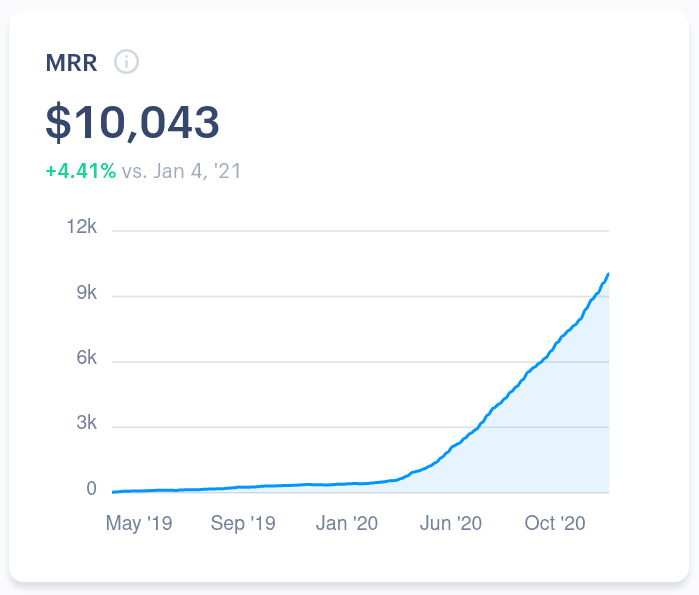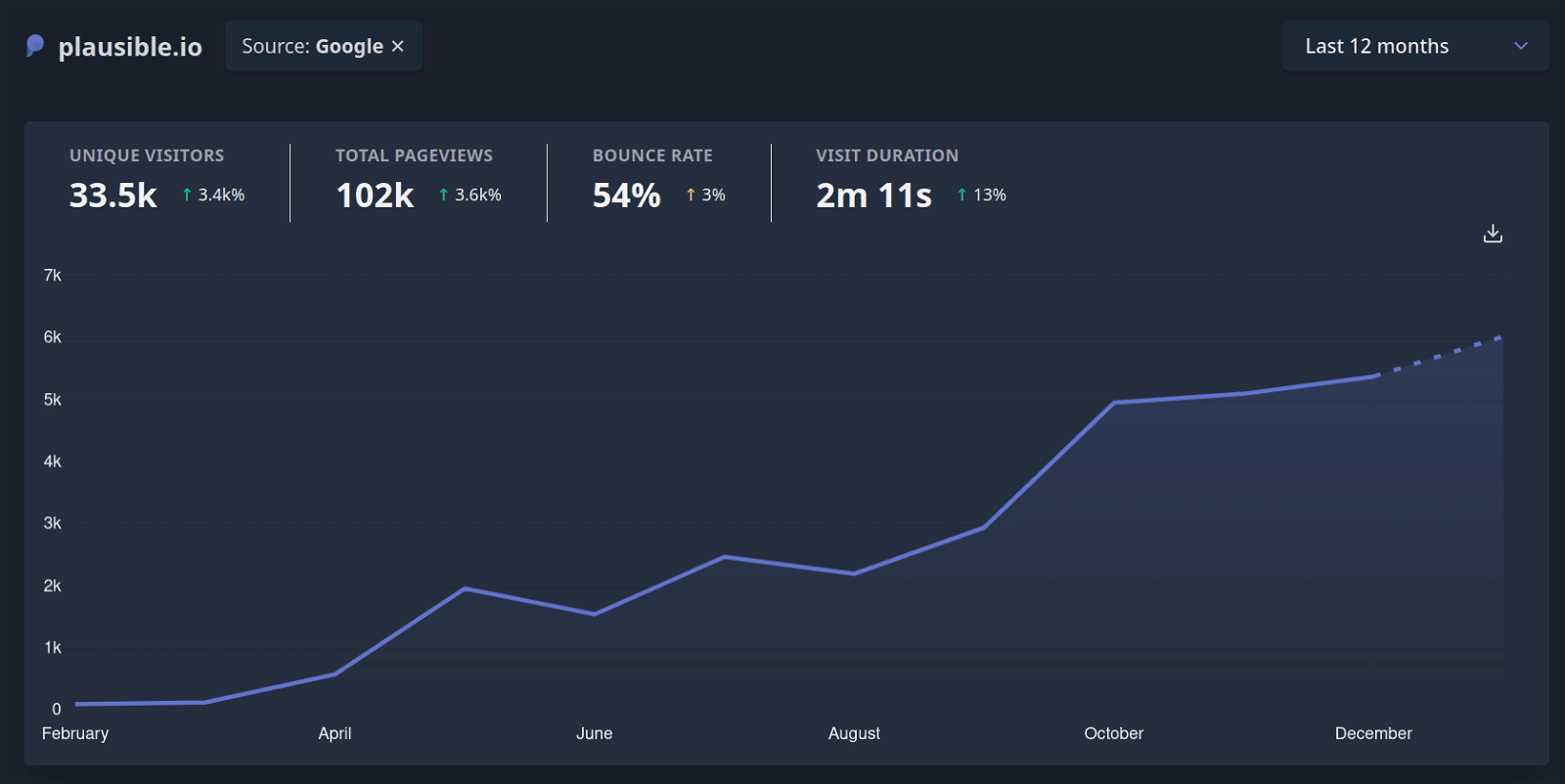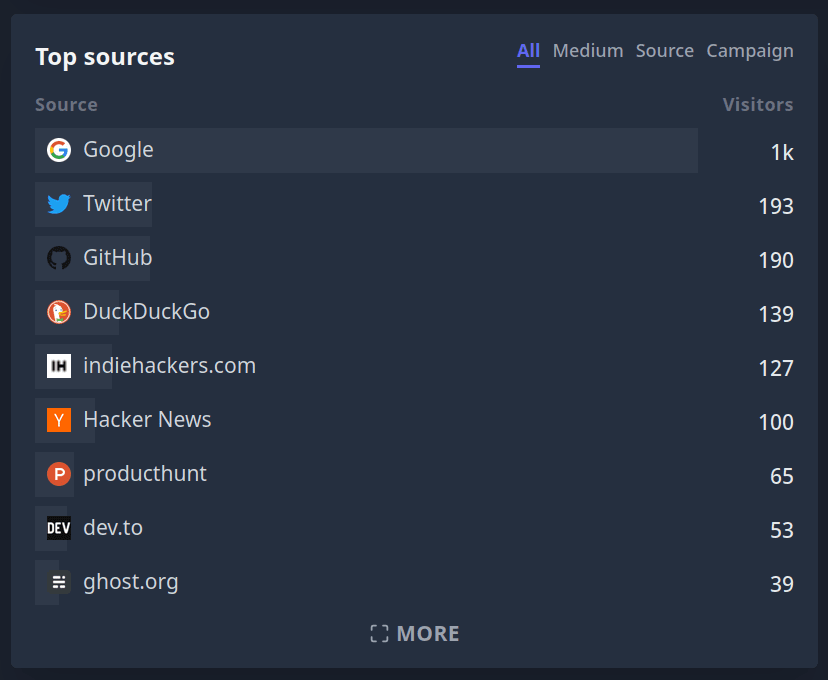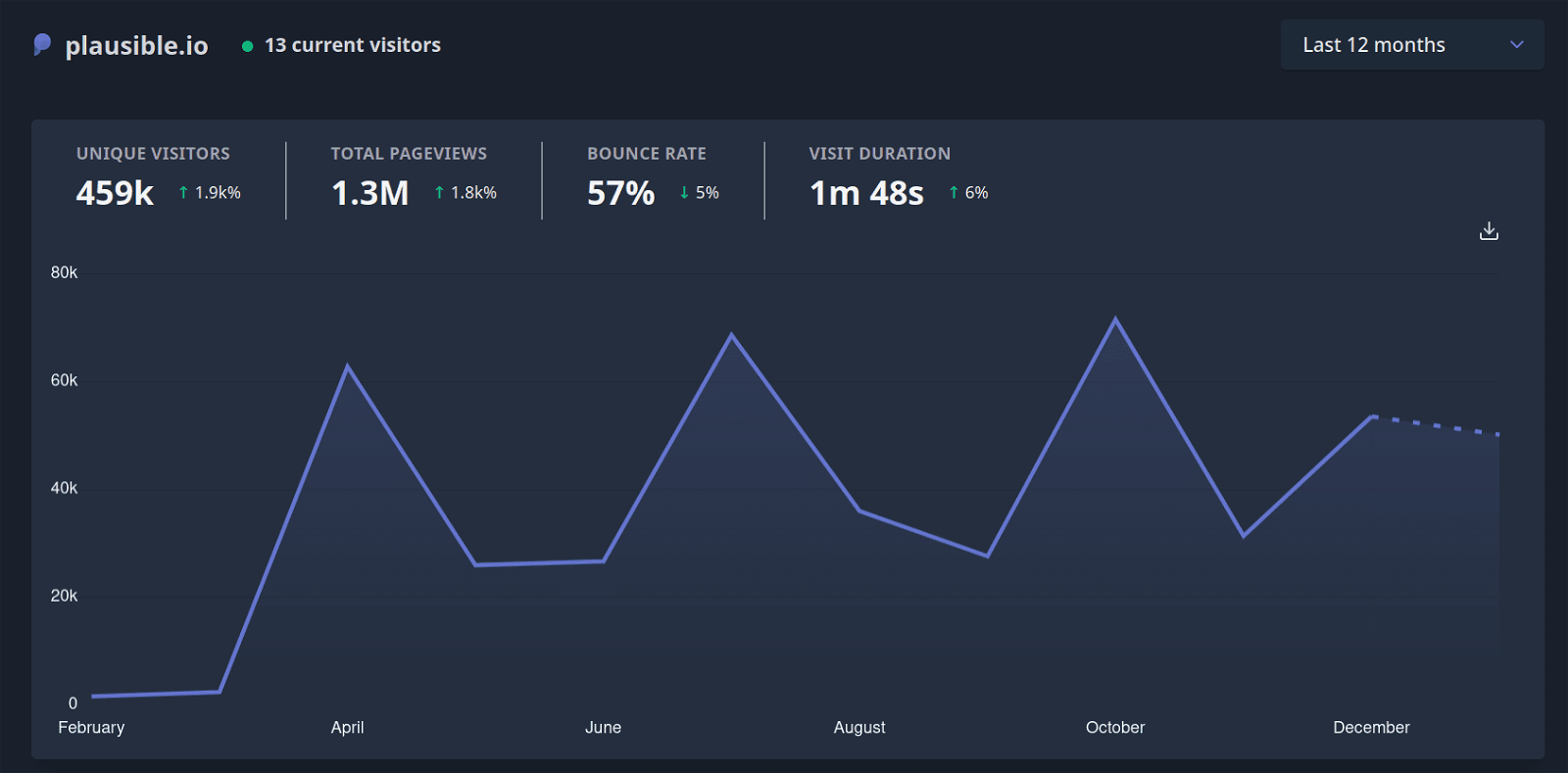What we learned on our journey to $10,000 MRR

We’ve made it to $10,000 MRR with Plausible! Several people asked about our lessons learned, so I wanted to share some in this post.
A brief introduction: Plausible Analytics is a simple, lightweight and privacy-first alternative to Google Analytics. We’re a completely independent and bootstrapped team of two.
As we say no to the adtech and surveillance capitalism, we also don’t use Facebook and Google ads to grow Plausible. In addition to this, we’re an open source project that is transparent in everything we do.
Here are some of the lessons we learned on our journey to $10,000 monthly recurring revenue.
- Set some small goals and get some quick wins
- Perfect is the enemy of good
- Be obvious in your positioning
- It’s OK if your marketing strategy is boring and lacks growth hacks
- You don’t need big resources and investors
- A great documentation will reduce your customer support
- You don’t need to charge more just because everyone says so
- Be flexible and adaptable in what you work on
- Don’t be worried about being transparent and open source
- Look for help
Set some small goals and get some quick wins
A few days ago, we got 17 trial signups from Google’s organic search results in one day. This made me think back on the first day I started working on Plausible after joining as the co-founder: March 16th, 2020.
I remember looking at our Google traffic stats on my first day. We had 0 visitors from Google on March 15th and one visitor on March 14th. There were a few 10+ visitors per day occasions in the previous months but no consistency and we were well below ten visitors per day on average.
My first goal was to get 10+ visitors from Google every day consistently. Nothing grand or crazy ambitious but something that was realistic and something that would tell us that we were making progress.
We made a plan that we hoped would get us there: publish regular content and make that content as useful as possible to the audience we are trying to reach.
Then we simply started taking small, regular steps towards reaching that tiny goal. And now, some nine months later, we’re at a stage where 10+ trial signups (not visitors!) from Google a day is not unusual. Google is one of our top traffic sources now and you can see our growth here.

I’m a big fan of small, short-term realistic plans and quick wins rather than long-term, multi-year ambitious goals that just turn out to be guesses.
Perfect is the enemy of good
Do what’s good enough rather than wait for an opportunity to make something perfect.
This is similar to the minimum viable product concept but we do it for everything except for the product. All our development time goes into improving the product itself and our infrastructure.
For all the other, not so essential things, we follow the minimum viable approach. We accept the small inconveniences to us and do what’s good enough. Some examples:
- We use a template design (with some custom work to make it look a bit different from the default) for our home page even though we could spend a lot of money and time to have it all custom-built
- We have a logo and some simple branding images on our site that we made ourselves even though we could spend some money and time on having a full suite of images and branding done by a professional designer
- We use a simple CMS for our blog and content editing experience even though it’s less user friendly and more cumbersome to work with than some of the more popular tools. Would be nice to make a move to something better but we’ve decided not to spend too much time on that
- For the open stats on our about page where we share numbers about our growth, we manually update the metrics once a month instead of building a proper, automatically updated integration
- For the “social proof” counter on our home page where we list the number of sites Plausible is installed on, the total number of pageviews counted and the uptime, we do the same. Manual update once a month for a handmade counter:

None of these are perfect, but all of them are more than enough to do what we need them to do. And this allows us to fully focus on product development and improving the product, the main thing people come to us for.
Doing what’s good enough doesn’t stop us from growing and it doesn’t make the user experience any worse than if we put a lot of time and resources in making it all perfect.
We may fix the things I listed in the future and make them “perfect” but when you’re bootstrapping, it’s important to focus on what can make a real difference to your startup becoming sustainable.
Be obvious in your positioning
This is probably the biggest mistake I see when I visit sites made by other indie hackers. It’s something we worked on immediately when I joined Plausible as a co-founder and it has made a tremendous impact.
You need to make it crystal clear and easy to understand immediately what you do, what you stand for and how you compare to whoever is the biggest name in your market (such as Google Analytics is in our market).
People are familiar with the big name you are up against, so instead of pretending it doesn’t exist, help your visitors understand the difference. People are impatient, so if you don’t do that, chances are you lose that visitor.
What we now have on the top of our home page is very clear and easy to understand within seconds:
Simple and privacy-friendly alternative to Google Analytics. Plausible is a lightweight and open-source website analytics tool. No cookies and fully compliant with GDPR, CCPA and PECR. Made and hosted in the EU 🇪🇺
And we keep repeating this and similar messages throughout our communication. It never gets boring.
If you want a more detailed look into our (re)positioning, see how one blog post changed the traction for our startup.
It’s OK if your marketing strategy is boring and lacks growth hacks
We have a boring marketing strategy and we say no to all the growth hacks and best marketing practices. Everyone loves hearing about growth hacks and 7-minute abs but in the end what matters is doing quality work and staying consistent with it.
We focus on a small number of things but we try to do them really well:
- Build a great product that people will recommend spontaneously. This is the key as without a great product nothing else would work.
- We stay active on Twitter, Mastodon, Indie Hackers, Hacker News and to a lesser degree Reddit.
- We publish a lot of content.
My co-founder Uku has been building the product for more than 2 years. I’ve been building the brand, content and social presence for 9 months full-time. Most of Uku’s time is writing code and most of my time is writing content and interacting on social.
No tricks. Just putting one foot in front of the other every day and focusing on the marathon not the sprint. Sometimes people see our recent success and think that it came overnight. In reality, we have invested thousands of hours of coding and writing in getting to this point.
Here’s a bit more on how we monitor the conversation around the web and how we publish content:
Monitor the conversation around the web
One of the marketing tactics that has worked very well for us and continues to work to this day is to follow what’s happening around the web related to our market.
Here’s how that looks like: I have TweetDeck set with ten columns or so searching Twitter for anyone talking about different topics relevant to Plausible Analytics.
These topics include Google Analytics, web analytics, alternatives, GDPR, cookie banners, privacy and on and on. When someone talks about these topics or asks a question, I can reach out and respond to them if it makes sense.
I do the same for Hacker News, Reddit and even for the wider web. In many cases, I simply use the native search but I also have tools such as F5Bot set up to send me notifications.
I basically aim to find people saying mostly negative things about their Google Analytics experience and I then reach out to them telling them how Plausible can make their experience better.
It’s probably the most natural way for you to find new people interested in what you’re doing - people that already talk about the problem you have a solution for. It may not be the most scalable tactic but it works and I still do it.
Content gives you a chance to be discovered
Content is really what drives the growth for us. We publish regular new content on our site. This includes blog posts, documentation pages, and different marketing pages about our features, usecases and problems we solve.
We focus on the quality of the content and publish a mix of current topics that might do well on social media and more search engine optimized stuff that focuses on problems we solve for people.
Each of these pieces gives us more opportunities to get discovered on Google and other search engines. And search engines are the best source of “quality” traffic to our website with Google being the top source of trial signups too.

In addition to potential traffic from search engines, content gives us something to submit to the various communities and niche aggregators. And people also share it in social media.
If you want a closer look at how we publish content, see how we bootstrapped our startup from $400 to $2,750 MRR in 135 days without ads.
You don’t need big resources and investors
I often hear that you cannot grow your startup when you don’t have a marketing team or don’t have an advertising budget. It is a mistake to think like that.
At Plausible, we’re indie hackers. We have no external funding so we’re completely self-funded and made sustainable by our subscribers’ fees.
Are we crazy to reject all the venture funds that regularly knock on our door? We don’t think so and we believe it is time for more startups to do things patiently and differently.
Having no investors means that we don’t have easy money we can throw at Google and Facebook funding them to do the marketing work for us. Our marketing budget is $0 if you don’t account for our own time. That doesn’t stop us from growing and from doing marketing though.
And our “boring marketing strategy” is very efficient. Being active in different niche communities is free. So is being involved in social media. So is writing blog posts and sharing them with various niche aggregators.
All these are great marketing channels that have helped us reach more than 450,000 people in the last 12 months and helped us grow from $400 MRR in April 2020 to more than $10,000 MRR at the time of writing.

A great documentation will reduce your customer support
I never understood the value of documentation until I started working on the Plausible documentation. Now I feel it’s a vital part of customer support.
The top of our “Contact” page says:
Our Documentation is a great place for most answers, but if you can’t find your answer there, please do contact us using the email address below.
We also link to our documentation prominently for our logged in users.
And when hearing from people, so many have told us how useful they found the documentation. It has made it possible for us to run a startup with 1778 paying customers and it’s still only the two of us doing all the work including customer support.
Growing your brand to get more social media mentions, more buzz and signups, also leads to more emails and questions, so think about how to do customer support more efficiently and not get overwhelmed.
You don’t need to charge more just because everyone says so
Basic and often repeated startup advice is to charge more. Add another 0 to your prices. Double it up. Things like that. That can work but you don’t need to follow it despite it being very commonly given advice. Consider your market situation and your potential audience when deciding the pricing.
Before Plausible entered this market, Matomo, one of the first ethical alternatives to Google Analytics, had premium prices for their service. Their cheapest plan started at about $30/month. Other alternatives charged similar rates as well.
An important consideration for us was the fact that Google Analytics is free of charge and people are not used to paying for web analytics. Our goal is to try and remove Google Analytics from as many websites as possible and we cannot achieve that by always charging more.
To incentivize more of the site owners to ditch Google, we wanted to offer fair and affordable prices. And so we did. Our plans start at $6 per month and there’s even a generous discount on annual billing.
This price point is much more attractive to many site owners who have never paid for analytics and would never consider switching to an alternative if they had to pay 5x or 10x more. We aim to always keep a fairly priced entry point to give owners of smaller sites a chance to de-Google too.
Be flexible and adaptable in what you work on
The first few months after I joined Plausible, I spent 90% of my time on writing new content and reaching out to people and websites trying to get traction.
More recently, as our marketing activities succeeded and we now have some traction, 90% of my time is spent on community management, public relations and customer support talking to people that reach out to us.
At first, I wasn’t sure if it was a good idea to reduce the amount of time I spend on proactive marketing activities and spend that time on the more reactive tasks. Now I see it as a natural part of the journey.
The early work was focused on increasing brand awareness and attracting people to try Plausible and now that so many people are showing interest, we better treat them nicely and give them a great experience so they also stick with us.
And now people who try Plausible and have a great and useful experience transitioning from Google Analytics help drive word of mouth and proactive marketing buzz for us.
Don’t be worried about being transparent and open source
We’ve managed all this with a privacy first and open source product built completely in public. All our development work and our codebase is available in the public. All our website traffic stats and revenue numbers are in the public too.
Many indie hackers have asked whether being transparent or open source is the way to go as they’re worried about potential negatives such as competitors knowing what you do or people taking your code.
My general advice is that being transparent and open is a great way to build trust and a great way to incentivize others to look at your project, share it, use it or even contribute to it.
So if being open source and transparent is something that speaks to you, go ahead without being too worried about the “…but what if…”. We’ve shared some of our lessons learned of building an open source project and I recommend you review them.
Look for help
Running, developing and growing a startup in a competitive market such as web analytics is challenging. There are many other indie hacking projects, many established alternatives and several major tech companies offering analytics too.
My co-founder Uku started developing Plausible and growing it on his own in December 2018. Just over a year into his journey, he decided that he needed some help in order to make Plausible sustainable and something that can become a viable project.
So he reached out to me and we started working together. Uku could now focus completely on the design and development of the product, while I could take care of the marketing, community management and customer support. We’ve shared more details on this in our Changelog Podcast appearance.
And with the two of us clearly focused on different but equally important tasks (development and marketing), we were able to make so much more progress than what anyone can do on their own.
That doesn’t mean that you do need to find a co-founder for your project but it can certainly help you speed up the progress.
Good luck on reaching $10k MRR with your project and have fun on this fantastic journey!